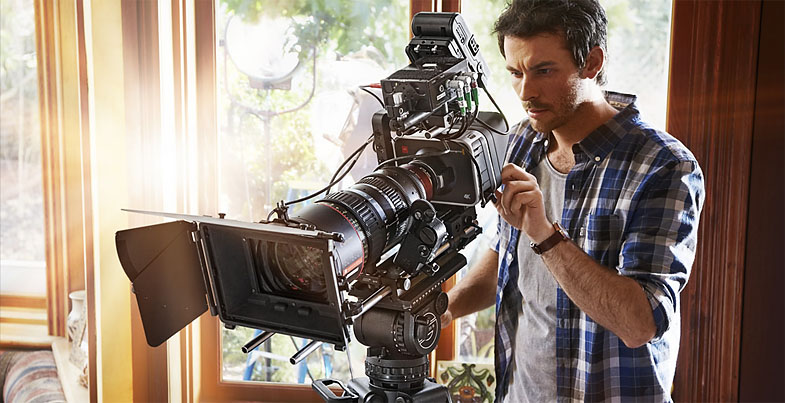
- Search
-
Login
-
0
ComparisonAdd products to compare, then they will appear here and you can compare parameters.
-
0
0 €Nothing in the basket.
News
Press Release
Blackmagic Design announced that all signal distribution at the event areas for this year’s Eurovision Song Contest (ESC), hosted at the Wiener Staatshalle in Vienna, Austria, was delivered via an SDI based live production workflow featuring six Blackmagic Design Smart Videohub routers.
The audiovisual (AV) infrastructure for the annual European wide extravaganza, now in its 60th year, was devised by Vienna based live event specialist Concept Solutions and distributes HD video signals to more than 125 monitors and screens throughout the multi purpose indoor arena.
As well as the main staging hall, where 60 countries competed for the chance to perform in a live two hour televised spectacular, the ESC also had dedicated halls for media, backstage and catering, the judging panel, VIPs and the official ESC delegation. Each was equipped with a multitude of displays and screens to keep attendees up to date and a Smart Videohub 12x12 or 20x20 was assigned to manage video signals for each individual zone. Three video channels produced by the production hub were delivered to screens; the main hall feed for rehearsals, semi finals and the grand finale, an information channel for competitors and an internal communications channel. More than a hundred Blackmagic Design Mini Converter SDI-HDMI were also installed throughout the arena’s SDI infrastructure.
Florian Weber of Concept Solutions explains the rationale for multiple video routers: “The hall based complex meant that each zone within the event were quite distinct, both in terms of purpose and location, and we had to balance this with a reliable, failsafe audiovisual workflow that would perform perfectly throughout weeks of rehearsals and performances. Assigning a router to each hall gave us a simple and clear structure for our signal distribution, and any issues would be quick to spot and rectify during a live production. The SDI infrastructure ensures we had reliable signal path throughout the complex that meets industry standards.”
“Each area was also distinct in terms of what the people in that particular room require in terms of information, so we have the ability to tailor the content they are watching depending on their needs. For example, the media room needed to get a real sense of the main hall events, whereas the backstage areas required a more varied flow of information and entertainment to keep the show running smoothly at all times. We rely on the Smart Videohub for many of our live events, and we knew that they would be the most effective choice for staging such a major spectacle.”

Press Photography
Product photos of Smart Videohub, MiniConverters and all other Blackmagic Design products, are available at www.blackmagicdesign.com.
About Blackmagic Design
Blackmagic Design creates the world’s highest quality video editing products, digital film cameras, color correctors, video converters, video monitoring, routers, live production switchers, disk recorders, waveform monitors and real time film scanners for the feature film, post production and television broadcast industries. Blackmagic Design’s DeckLink capture cards launched a revolution in quality and affordability in post production, while the company’s Emmy™ award winning DaVinci color correction products have dominated the television and film industry since 1984. Blackmagic Design continues ground breaking innovations including 6G-SDI and 12G-SDI products and stereoscopic 3D and Ultra HD workflows. Founded by world leading post production editors and engineers, Blackmagic Design has offices in the USA, UK, Japan, Singapore and Australia. For more information, please go to www.blackmagicdesign.com.
The new Blackmagic Camera 2.4 software update adds frame guides support and new camera control setup software for Blackmagic Production Camera 4K as well as general performance improvements.
Press Release
Blackmagic Design announced that Marvel’s “Avengers: Age of Ultron” 2nd Unit shot extensively on the Pocket Cinema Camera. Joss Whedon’s highly anticipated sequel to “Marvel’s The Avengers” was lensed by cinematographer Ben Davis (“Guardians of the Galaxy”).
When Tony Stark tries to jumpstart a dormant peacekeeping program, things go awry and Earth's mightiest heroes are put to the ultimate test, as the fate of the planet hangs in the balance. As the villainous Ultron emerges, it is up to the Avengers to stop him from enacting his terrible plans, and soon uneasy alliances and unexpected action pave the way for an epic adventure.
The film differs quite significantly from the original Avengers movie. “The first was about a coming together, whereas this film is about a coming apart, which is reflected in the tone of the script,” explains Ben. “The narrative of the film is far more dark and menacing, so the visual approach was grittier, darker and more earthbound.”
“Avengers: Age of Ultron” features an extensive amount of 2nd Unit work and Davis required a small, high quality digital film camera for the film’s stunt sequences. “I was a big fan of what Anthony Dodd-Mantle had achieved on “Rush” using small camera platforms, especially when it came to mounting them in unusual places and the shots he was able to achieve,” he reveals. “I decided to get a Pocket Cinema Camera in for testing after bumping into DIT friend of mine who’d recently purchased a one, and was raving about it. For me, it was a no-brainer really, it was all about the latitude and size. Suddenly I had a small camera which not only output a 12-bit RAW image, but it also had a latitude that was getting up to and around the level of high end digital cinema film cameras.”
“There are two large battle sequences in particular during the film, the first is at the beginning and the second features in the third act, and we very much wanted these to be shot as a war correspondent would cover news in a conflict zone. What we needed was a lightweight camera that we could then distribute around the set during the filming of battle sequences that would give us more than twelve frames of good quality HD material that we could match with our main camera package. For this we used eight Pocket Cinema Cameras paired with either a 14mm pancake lens or a 12-35mm zoom, which we then mounted to impact points around the set. Say for example a truck was being blown up and thrown through the air and we wanted to capture it landing on top of a car, we would put one of the Pocket Cinema Cameras in a small metal housing and put it in the car. Another instance involved mounting the Blackmagic camera to a tank, because we could literally strap it one on the end of a magic arm and bolt it to almost anywhere we wanted it to be on the tank.”
“When I got the Pocket Cinema Cameras in I thought they would be a nice to have, however I ended up using these far more than I ever thought we would,” concludes Ben. “The appealing thing about this camera is its size to quality ratio. The footage is usable for a much longer cut time than previous incarnations of small camera platforms and so the camera does in fact become far more useful.”

Press Photography
Product photos of the Blackmagic Pocket Cinema Camera are available at www.blackmagicdesign.com/press/images.
About Blackmagic Design
Blackmagic Design creates the world’s highest quality video editing products, digital film cameras, color correctors, video converters, video monitoring, routers, live production switchers, disk recorders, waveform monitors and real time film scanners for the feature film, post production and television broadcast industries. Blackmagic Design’s DeckLink capture cards launched a revolution in quality and affordability in post production, while the company’s Emmy™ award winning DaVinci color correction products have dominated the television and film industry since 1984. Blackmagic Design continues ground breaking innovations including 6G-SDI and 12G-SDI products and stereoscopic 3D and Ultra HD workflows. Founded by world leading post production editors and engineers, Blackmagic Design has offices in the USA, UK, Japan, Singapore and Australia. For more information, please go to www.blackmagicdesign.com.
Until June 30th, 2015, any EDIUS Neo user (versions 1 to 3.5) or EDIUS Pro user (versions 1 to 6.5) is able to upgrade to EDIUS 7.5 for just 299 EUR. This update will also include a free update to the next major version of EDIUS when it is available. The upgrade is provided in serial key format only, not as a packaged product. Upon purchase, users download the software and enter a serial number that they get with their upgrade. This is a limited-time promotion, ending June 30th, 2015!
Press Release
Blackmagic Design announced that the Fédération Française de Tennis (FFT) video production team will monitor all of the action at this year’s French Open using eight Blackmagic MultiView 16s. The purpose built 3.2 meter by 1.3 meter video wall provides a complete preview of all the action as it happens at Le Stade Roland Garros, Paris’ international tennis venue.
As part of a major video production upgrade for the venue, four of the hardware multi viewers will be used all year round in order to monitor 1080i50 signals across all 20 courts at Roland Garros, including smaller FFT tournaments and training analysis. During major championships, such as the French Open Gram Slam tournament and Davis Cup meetings, the additional four MultiView 16s provide the FFT team with a full overview of every camera feed being produced by up to 40 international sports broadcasters on site, as well as outputs of video systems such as keyers and video walls.
“Blackmagic’s hardware multi viewers replace several full IP mosaics and SDI video quads that we previously used for monitoring. As well as assisting in our overall upgrade of our inhouse production capabilities from SD to HD, the multi viewers also allow us to be more flexible by taking video outputs straight from our SDI video routers to see whatever we need directly up on our screens,” explains Christophe Chatain, head of AV, FFT. “Whilst most of our sources for this Grand Slam tournament are HD, as is the case with other international events, the fact that we can support Ultra HD monitoring in the future, and select how we view those inputs; either full screen or 2x2, 3x3 or 4x4 means we have a flexible, reliable monitoring solution that is future proofed.”
The FFT has also recently installed two Blackmagic Smart Videohub 40x40 routers as part of its upgrade of the venue’s audiovisual infrastructure. The first is used to distribute video feeds between the stadium’s multiple control rooms via optical fiber out to giant screens for spectators or to the venue’s IPTV network while the other manages all of the incoming sources for the video wall in the master control room, routing the MultiView 16 inputs and outputs.
“As the only Grand Slam tournament played on clay, the French Open is a major international tennis event, attracting sell out crowds and broadcasters from across the globe, so it goes without saying that our on court coverage has to be flawless, and the production team has to have its finger on the pulse as the drama unfolds,” concludes Christophe. “The installation of Blackmagic Design’s routing and monitoring equipment delivers a reliable and seamless video production workflow that enables us to provide broadcast standard video coverage of some of tennis’ most exciting matches, from the very best in the sport.”

Press Photography
Product photos of MultiView 16, Smart Videohub 40x40 and all other Blackmagic Design products, are available at www.blackmagicdesign.com.
About Blackmagic Design
Blackmagic Design creates the world’s highest quality video editing products, digital film cameras, color correctors, video converters, video monitoring, routers, live production switchers, disk recorders, waveform monitors and real time film scanners for the feature film, post production and television broadcast industries. Blackmagic Design’s DeckLink capture cards launched a revolution in quality and affordability in post production, while the company’s Emmy™ award winning DaVinci color correction products have dominated the television and film industry since 1984. Blackmagic Design continues ground breaking innovations including 6G-SDI and 12G-SDI products and stereoscopic 3D and Ultra HD workflows. Founded by world leading post production editors and engineers, Blackmagic Design has offices in the USA, UK, Japan, Singapore and Australia. For more information, please go to www.blackmagicdesign.com.

